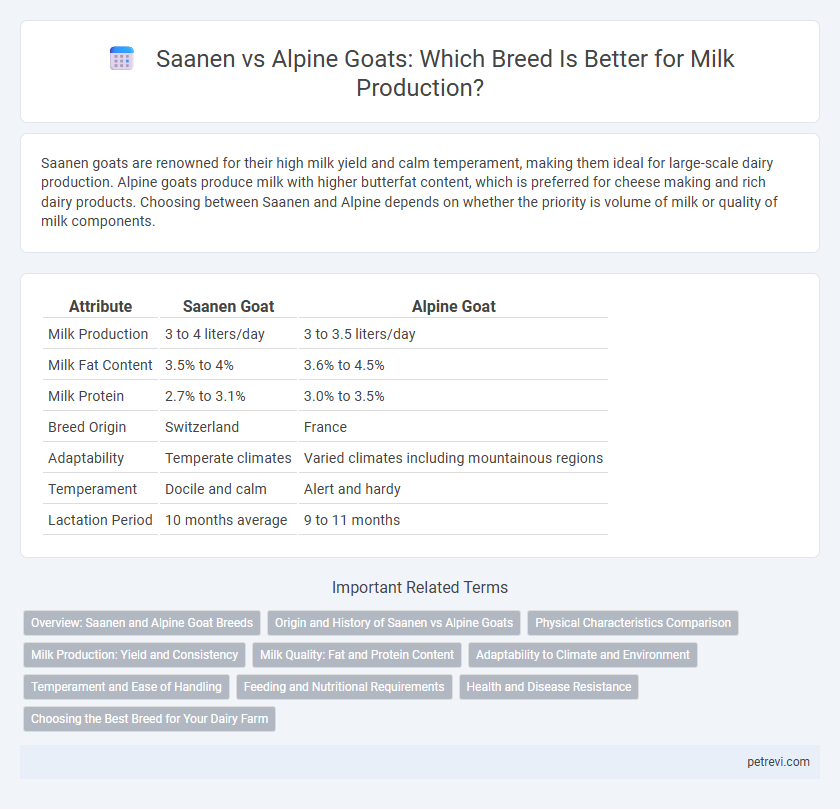Saanen goats are renowned for their high milk yield and calm temperament, making them ideal for large-scale dairy production. Alpine goats produce milk with higher butterfat content, which is preferred for cheese making and rich dairy products. Choosing between Saanen and Alpine depends on whether the priority is volume of milk or quality of milk components.
Table of Comparison
| Attribute | Saanen Goat | Alpine Goat |
|---|---|---|
| Milk Production | 3 to 4 liters/day | 3 to 3.5 liters/day |
| Milk Fat Content | 3.5% to 4% | 3.6% to 4.5% |
| Milk Protein | 2.7% to 3.1% | 3.0% to 3.5% |
| Breed Origin | Switzerland | France |
| Adaptability | Temperate climates | Varied climates including mountainous regions |
| Temperament | Docile and calm | Alert and hardy |
| Lactation Period | 10 months average | 9 to 11 months |
Overview: Saanen and Alpine Goat Breeds
Saanen goats are renowned for their high milk yield, producing up to 3 liters per day with a creamy, mild-flavored milk ideal for dairy products. Alpine goats offer versatility with moderate to high milk production, averaging 2 to 2.5 liters daily, and their milk contains more butterfat, enhancing richness. Both breeds excel in milk quality and volume, making them top choices for commercial dairy farming.
Origin and History of Saanen vs Alpine Goats
Saanen goats originate from the Saanen Valley in Switzerland and are known for their high milk yield and calm temperament, making them a preferred dairy breed worldwide. Alpine goats, native to the French Alps, possess a strong adaptability to diverse climates and a robust constitution, alongside producing milk with higher butterfat content. Both breeds have been selectively bred over centuries, enhancing their dairy qualities--a legacy that continues to influence modern goat milk production.
Physical Characteristics Comparison
Saanen goats exhibit a predominantly white coat, larger body size, and a sturdy skeletal frame, making them easily distinguishable from Alpine goats, which display a variety of coat colors and a more slender, athletic build. Saanens typically weigh between 70-90 kg with a height of around 90 cm at the withers, while Alpines generally weigh 65-80 kg and stand slightly shorter. The smoother, short-haired coat of the Saanen contributes to heat tolerance, contrasting with the Alpine's thicker, sometimes longer hair adapted for varied climates.
Milk Production: Yield and Consistency
Saanen goats are renowned for their high milk yield, producing an average of 3 to 4 liters per day with consistent lactation throughout the season. Alpine goats also deliver substantial milk quantities, typically around 2.5 to 3 liters daily, but their output can vary more due to environmental factors. Both breeds provide milk with excellent quality, yet Saanens stand out for superior volume and stable production, ideal for commercial dairy operations.
Milk Quality: Fat and Protein Content
Saanen goats produce milk with lower fat content, typically around 3.5%, but higher volume, making them ideal for dairy operations focused on quantity. Alpine goats yield milk with higher fat and protein content, often exceeding 4% fat and 3.5% protein, providing richer milk better suited for cheese and artisan dairy products. The choice between Saanen and Alpine depends on whether the priority is high milk volume or superior milk composition for quality dairy production.
Adaptability to Climate and Environment
Saanen goats excel in temperate climates due to their white coats reflecting sunlight and higher tolerance for heat, making them suitable for moderate environments. Alpine goats demonstrate superior adaptability to varied and rugged terrains, tolerating colder climates and fluctuating weather conditions well. Both breeds provide efficient milk production, but Alpine goats are preferred in regions with more extreme environmental changes.
Temperament and Ease of Handling
Saanen goats are renowned for their calm temperament and ease of handling, making them ideal for novice farmers and large-scale dairy operations. Alpine goats, while generally friendly, can exhibit more spirited behavior requiring experienced management for effective milking and care. Choosing Saanen for goat milk production often translates to smoother daily handling and reduced stress for both the animals and handlers.
Feeding and Nutritional Requirements
Saanen goats require a balanced diet rich in energy, protein, and minerals to support their high milk yield, with a particular emphasis on maintaining adequate fiber for rumen health. Alpine goats have slightly higher nutritional needs due to their robust milk production and adaptability, requiring more forage diversity and supplemental vitamins to optimize lactation. Both breeds benefit from a diet formulated around quality hay, grains, and fresh water to maximize milk volume and quality.
Health and Disease Resistance
Saanen goats exhibit strong resistance to common diseases such as mastitis and internal parasites, contributing to consistent milk quality and herd health. Alpine goats also possess notable disease resilience, particularly in adapting to varying climates and resisting respiratory infections. Both breeds require regular health management, but Saanen goats are often favored for their robust immune response and lower incidence of common dairy goat illnesses.
Choosing the Best Breed for Your Dairy Farm
Saanen goats are renowned for their high milk yield, producing an average of 3.8 liters per day with excellent butterfat content, making them ideal for large-scale dairy farms prioritizing volume. Alpine goats, while slightly lower in volume at about 3.0 liters per day, offer superior milk quality with higher protein levels, benefiting farms focused on cheese production and premium dairy products. Choosing between Saanen and Alpine depends on specific farm goals, including milk quantity, component quality, and adaptability to local climate conditions.
Saanen vs Alpine for Goat milk production Infographic

 petrevi.com
petrevi.com